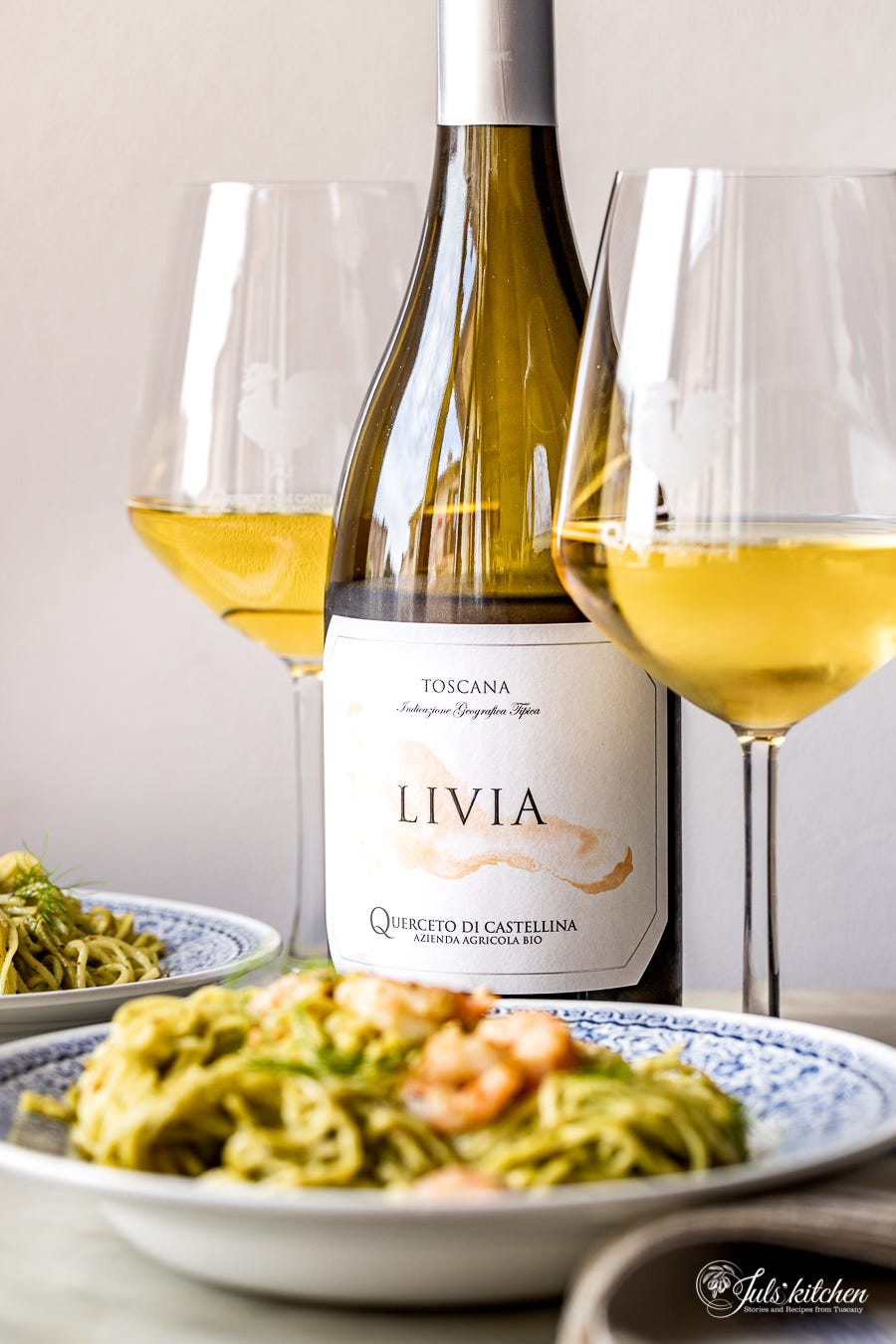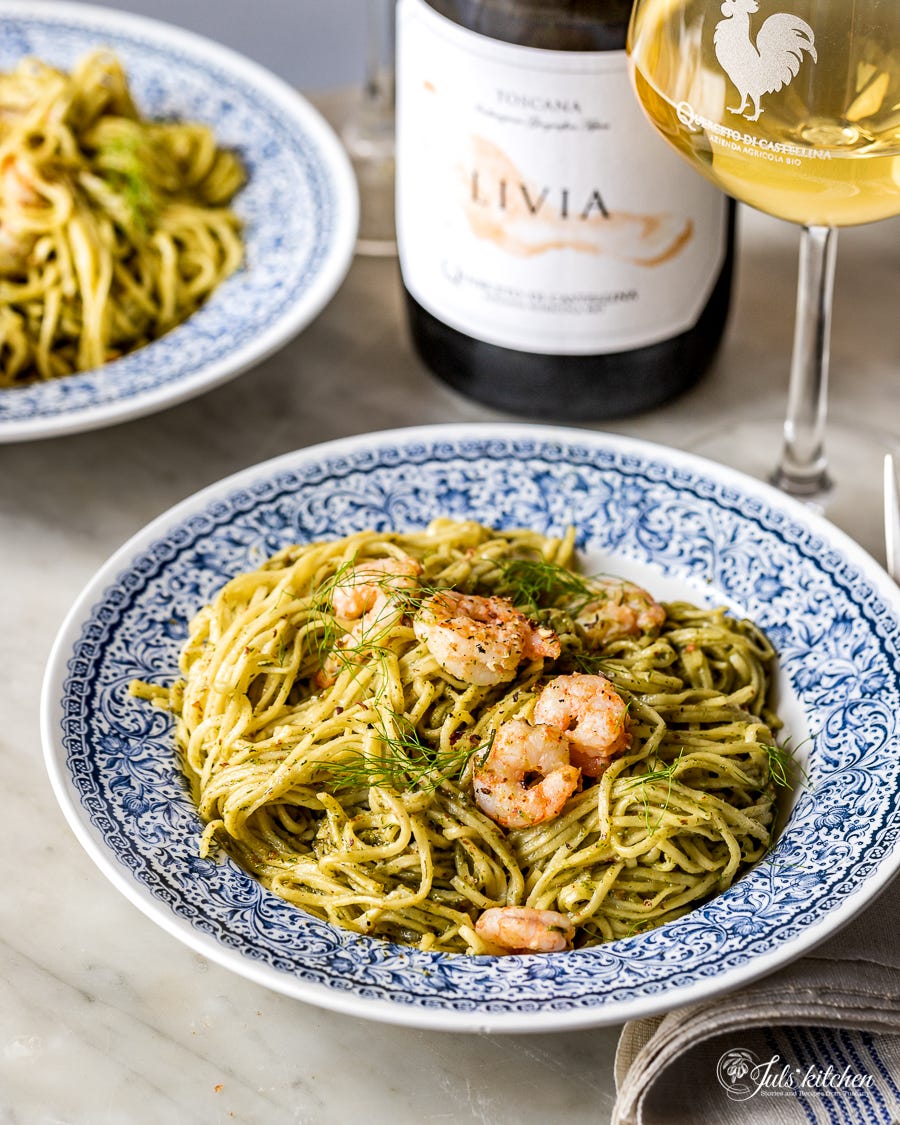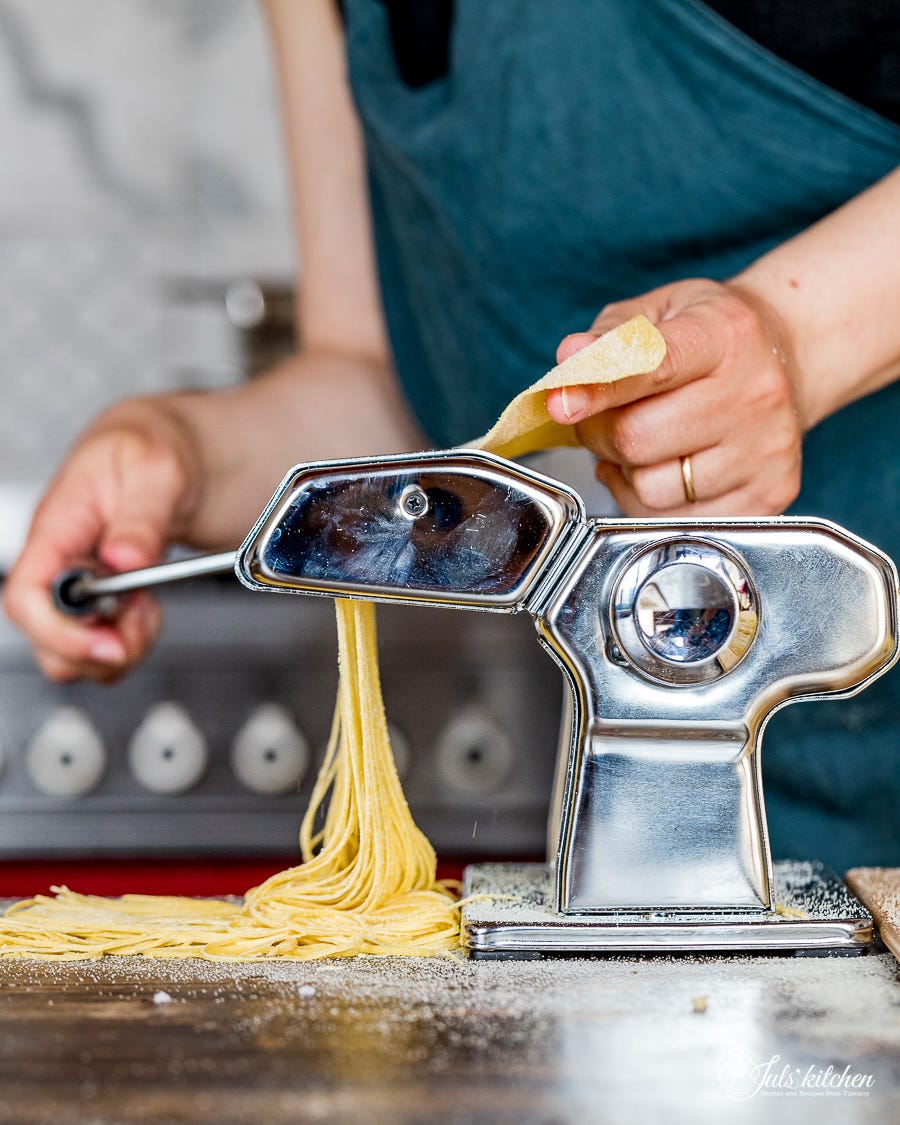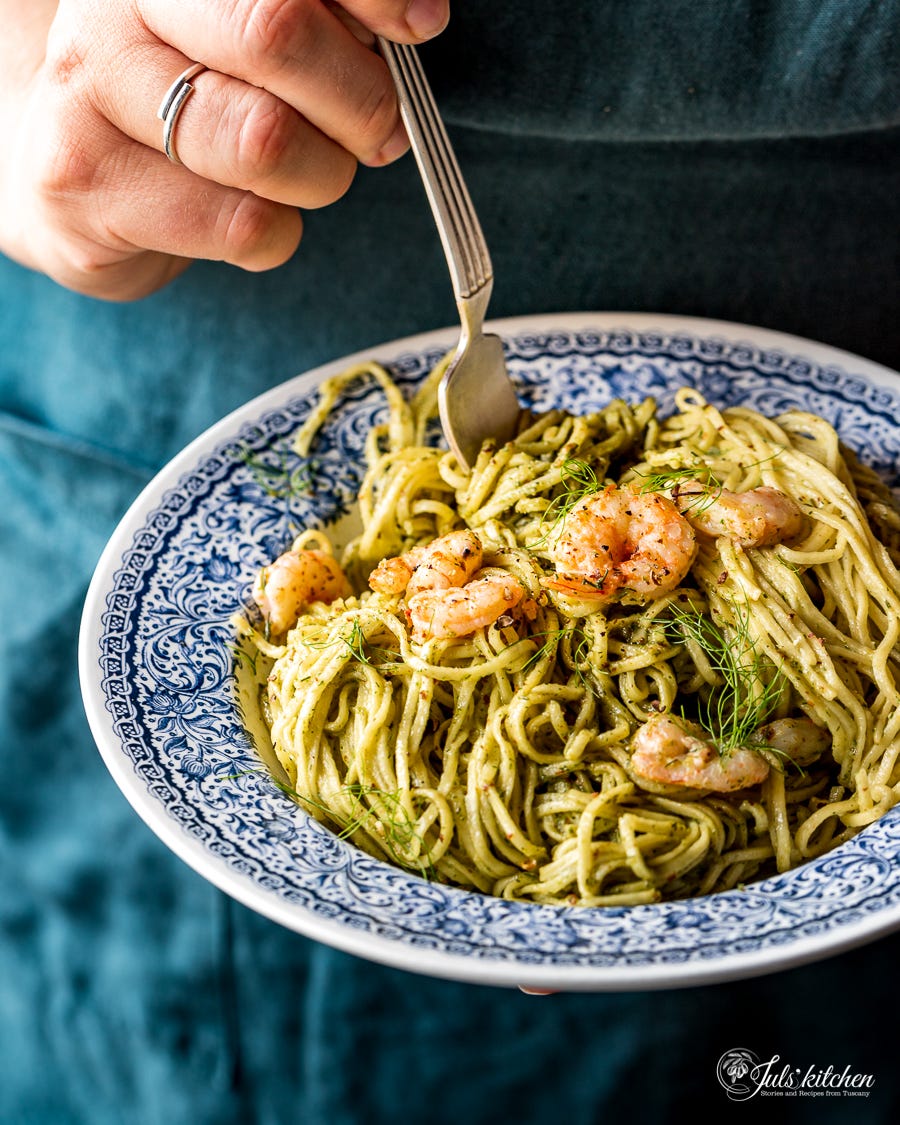Shrimp and wild fennel pesto tagliolini
The beginning of summer is the perfect moment to make wild fennel pesto. You can spot wild fennel from afar.
Who doesn’t love a big bowl of homemade pasta? Isn’t it the best way to welcome the new week? It is even better if it is paired with a splendid local white wine that bears the same name as my daughter, Livia.
As we announced in a previous newsletter, June will be dedicated to Italian recipes paired with the wines of our friends at Querceto di Castellina. We’ve visited their organic agriturismo and winery often during the past years for candle-lit vineyard dinners, summer lunches, and Thanksgiving parties.
So we’re very honoured and happy to bring you five Italian recipes in partnership with Querceto di Castellina, paired with their wines.
After Furtivo, an IGT Toscana Rosé that we paired with beetroot carpaccio and slow-roasted tomato and stracciatella crostoni, let’s move on to the second wine, a wine I truly love, not just for its name.
The only white wine produced by Querceto di Castellina, Livia is a unique blend of two French grapes and named after the sole granddaughter in the family – who happens to be part Italian and part French. The wine label features Livia's wee footprint from when she was about two or three months old.
The wine glints light gold in colour with subtle scents of white peach, apricot, and roses. On the palate, the grapes Viognier and Roussanne blend beautifully and luxuriantly together. The flavours are ripe but retain a refreshing crispness - even at the height of summer, this single vineyard enjoys cool nights – and the time the wine spends in tonneau contributes subtle notes of vanilla pod seeds and almond.
Remember that if you subscribe to the Querceto newsletter, you will receive a 10% discount on your first online order. You will also be kept in the loop on all of the news and offers coming from Querceto di Castellina.
They also created a special offer for you!
A 6 bottle box with: 1 Igt Toscana Rosé Furtivo 2020, 1 Igt Toscana Bianco Livia 2019, 2 Chianti Classico DOCG L’aura 2018, 2 Chianti Classico DOCG Gran Selezione Sei 2017. The cost is 135€ instead of 150€ (shipping non included) + you will have the chance to enjoy a special 45 minute zoom tasting with Mary and Jacopo from Il Querceto.
Contact Mary at wineorders@querceto.com to purchase this special box, requesting for the Juls’ Kitchen special box.
And now, to the recipe.
Shrimp and wild fennel pesto tagliolini
As much as I love a robust meat or game sauce, or a rich cheese sauce, I prefer a more delicate sauce when enjoying good, homemade fresh pasta. The beginning of summer is the perfect moment to make wild fennel pesto.
You can spot wild fennel from afar. It loves growing along white roads with poppies, mint, and other wild herbs I am pretty sure would be good in salads or soups. There is this primordial satisfaction in foraging herbs for your meal. Even if you can now afford daily trips to the supermarkets and even expensive shopping at your local farmers’ market, nothing beats walking just outside your gate and picking up some fennel fronds for your next meal, trying not to be dragged away by your dog sniffing an exciting game trace.
It is the wild version of the cultivated variety: it has the same distinct anise aroma of the sweet, crisp bulbs you can buy at the market.
Wild fennel is quite common in Tuscan cuisine: we use the fronds for pesto, or to dress potatoes and fish, the seeds to give the unmistakable aroma to pork liver, the flowers and pollen to spice up local salami such as finocchiona, and even the stalks, to make pork skewers.
It is tricky to find a substitution for wild fennel. So, if you cannot forage or purchase wild fennel at the local farmers’ market, make instead a basil pesto following this recipe.
Fresh Pasta tagliolini
Serves 4-6 people
200 grams (1 2/3 cup) all-purpose flour
200 grams (1 ¼ cup) semolina flour
4 medium eggs
Pinch of salt
1 teaspoon extra virgin olive oil
Combine the two flours on a wooden working surface and shape them into a mound with a large well in the centre. Crack in the eggs, then pour in the olive oil and add a pinch of salt. Using a fork, stir slowly, starting from the centre of the eggs and gradually picking up more flour from the edges, whisking as if you are beating eggs for an omelette. When the dough turns crumbly, switch to kneading with your hands.
Continue kneading the ball of dough until the gluten starts to develop, as this will render the sheets of pasta stronger. The movement is all in the wrist: roll the dough outwards and away from you with the heel of your palm, then fold it back over onto itself and repeat the rolling movement. When the ball of dough is smooth, silky, and no longer sticky, wrap it in plastic wrap and let rest for 30 minutes at room temperature before using it.
After the resting time, roll out the dough into a large, thin sheet. You can use a classic rolling pin or a pasta machine. Either way, the most important thing is to keep rolling and flipping and rolling and flipping until you get a paper-thin dough.
Let the pasta sheets dry on a wooden surface dusted with semolina flour for about 20 minutes. Then, cut the sheets into thin noodles: You can use the tagliolini attachment for the pasta machine or a very sharp knife. To cut with a knife, loosely roll up the pasta sheet, cut it into thin strips, then unfold and loosely toss them. Arrange the tagliolini on the wooden surface or a large tray, sprinkled with more semolina, to dry. They can be used straight away or dried for about 1 hour.
Wild fennel pesto
Serves 4-6
For the wild fennel pesto
40 grams (1 1/3 oz) wild fennel fronds
70 grams (½ cup) almonds, slightly toasted
100 ml (½ cup) extra-virgin olive oil
50 grams (½ cup) grated Parmigiano Reggiano
Fine sea salt
For the shrimps
600 grams (1 1/3 lb) shrimps
2 tablespoons extra-virgin olive oil
1 clove garlic
Fine sea salt
Freshly ground black pepper
Rinse the wild fennel fronds under running water and dry them thoroughly, either with a kitchen towel or in a salad spinner.
In a food processor, add almonds and olive oil, blend until the almonds are roughly chopped, then add the wild fennel. Finally, blend into a creamy pesto.
Scrape the wild fennel pesto into a bowl, then add the grated Parmigiano Reggiano and the salt. Cover with a film of extra virgin olive oil and keep in the fridge for 2 days, or use it immediately to dress the pasta.
Shell the shrimps and collect them in a bowl.
Heat the olive oil in a skillet with a clove of garlic, then add the shrimps and cook them for a few minutes. Season with salt and pepper and set them aside.
Cook the tagliolini in boiling salted water, then drain it when al dente. Keep a few tablespoons of the pasta cooking water aside to dilute the pesto, should it be too thick.
Dress the pasta with the wild fennel pesto, add the shrimps and finish with a drizzle of extra virgin olive oil.
Toss and serve the pasta immediately.
If you make these recipes, share them via email and send me a picture at juls@julskitchen.com, or on Social Media using the hashtags #myseasonaltable #julskitchen and #lettersfromtuscany, and tag @julskitchen
Do you know you can gift a subscription to Letters from Tuscany to your loved ones? It could be a perfect gift for your friend who wants to learn to cook, or for your daughter who’s missing Italy or your mum, dad, aunt, brother, grandma… anyone interested in Italian food!
Join our virtual cooking classes
We are missing the people we used to meet during our market tours and cooking classes. So we had to figure out a new way to share our passion for food, to virtually meet all the food enthusiasts who gave us so much through the years. This is why we launched a virtual Tuscan cooking class on Udemy, an online learning platform.
We’ve been working on new courses and videos. Read more about the courses here on the blog to stay updated.
Virtual cooking courses currently available:
Each course includes:
step-by-step cooking demonstrations,
a PDF with ingredients, tools, and instructions of each recipe,
lifetime access,
free access to upcoming new recipes.







